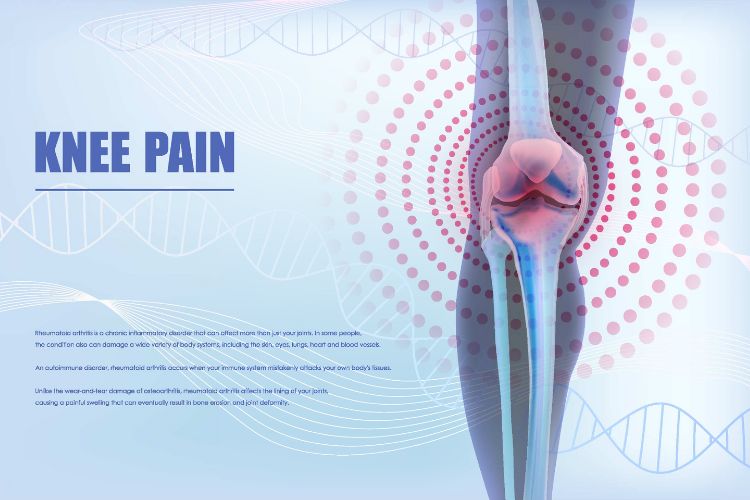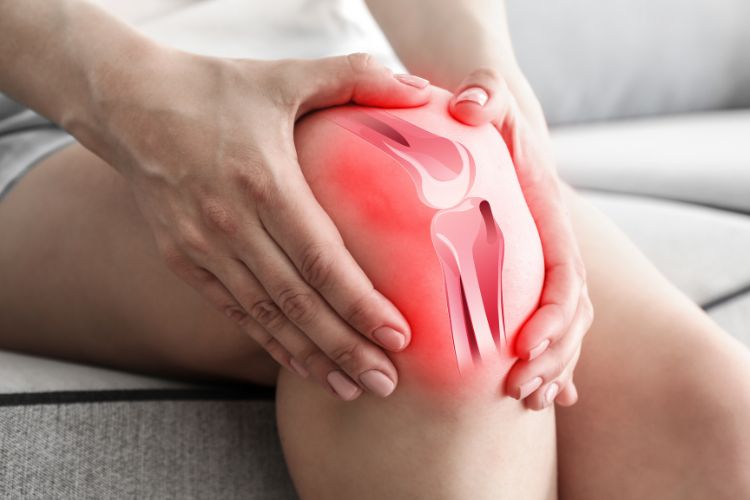When you have a burning sensation in your knee, the pain can seem unbearable. Sometimes it is not severe pain, but the pain is prolonged and consistent and becomes a problem in your life. Knee burning pain is real and there are many different factors. Burning knee pain impacts millions of Americans every year, with approximately 600,000 of those with burning knee pain requiring total knee surgery every year.
The symptoms of knee burning sensations can be sharp and shooting, burning, and throbbing in the knee joints. There are many ways to treat knee pain, with many of them being at-home remedies that treat the burning pain on the inside of knee joints.
You might start with compression and elevation techniques to treat knee pain or may have pain so severe you need surgery. Learn more about the burning sensation in knee joints and its treatment options here.
Causes of Burning Sensation in Knee
There are many different causes of a burning sensation in knee joints. You might have an injury such as a meniscus tear, but arthritis, inflammation, and medical conditions such as osteoarthritis or gout are all contributors to the burning sensation in knee joints.
Meniscus Tears
Meniscus tears are tears of the knee portion known as the meniscus and are very common knee problems. On the leg, the shin and the thighs are separated by a piece of cartilage that is called the meniscus. If the knee twists suddenly or is injured, this meniscus can tear. The result is a burning sensation in knee joints and tissues that can seem unbearable at times.
Torn ligaments can also cause knee pain. The anterior cruciate ligament (ACL) is an area on the knee that suffers tears as well. This is the ligament between the knee cap and the lower leg bone. When the ACL is torn, it is among the most common injuries to the knee.
Knee Arthritis
Knee arthritis is another very common knee problem. This occurs when the cartilage in the knee joints becomes damaged or worn out. The most common kinds of arthritis that impact the knees are osteoarthritis and rheumatoid arthritis.
This kind of pain is also a burning kind of pain, that may last longer than other kinds of knee pain. You will also find limited motion and range with your knee.
Knee Inflammation
When the muscles and tissues surrounding your knee joints are inflamed, you may also experience a burning sensation in the knee. Gout of the knee is a very common inflammation that can cause knee problems. This kind of knee pain is caused by an excess of uric acid in the blood.
If you see large swollen red knots or bumps around the knee joint or tissue, you may have knee gout. This is a condition that will come on suddenly and is extremely painful.
Medical Conditions — Gout, Bursitis, Osteoporosis
Another very common cause of knee pain that is caused by inflammation is bursitis. Bursitis refers to an inflammation of the bursa, a fluid-filled sac that sits between your knee bones and the surrounding tissues. The purpose of the bursa sacs is to prevent friction from your bones with the surrounding tissue.
The knee has approximately 15 bursa sacs that provide this cushioning. When these sacs are inflamed, there will be an awful burning sensation in knee caps and knee joints. In many cases, this pain can be treated with rest and compression, and sometimes non-steroidal anti-inflammatory medications (NSAIDs).
Osteoporosis and osteoarthritis are other common causes of knee-burning sensations. This occurs when the cartilage in between the bones begins to wear down, and is a permanent condition. This kind of knee burning is seen in people over the age of 50 whose joints have begun to wear down, wearing down the cartilage between them.
Iliotibial band syndrome (IBT) is another medical condition that causes knee burning sensations. This syndrome occurs as a result of repetitive injury to the tissue between the knee and the shin. It is a problem that occurs most often with athletes and long-distance runners.
If you are an athlete chronically complaining “my knee burns” you may have IBT and may need to take a break from running or sports in order to heal. Breaks and rest are common treatments of burning knee pain, and will help you to perform better when the rest period is over.

Symptoms of Burning Sensation in the Knee
The primary symptoms of knee burning sensation are in the name of the issue itself. The most common symptoms are:
- Pain
- Swelling
- Inflammation
- Limited range of motion
You will experience pain and swelling around the knee, in addition to moderate to severe pain around the knee area. You may also have a shooting pain that goes up or down the leg, depending on what tissues the pain is impacting. The knee may experience some stiffness that impacts your mobility. You may also have a difficult time indicating the range of motion with your knee, such that it appears as if your knee can only move a little bit.
The cause of your burning knee pain will not always determine what your symptoms are. Still, most symptoms of knee burning sensation are similar across all known causes. This can make a diagnosis of knee pain difficult, particularly if the knee pain is chronic or long-lasting.
If your burning knee pain is causing a quality of life issue, where you can not function with your daily activities for an extended period of time, see a doctor. You may have a knee problem that can be easily diagnosed and treated quickly. Not all knee pain requires surgery, and a good doctor will do everything they can to avoid that.
Treatment Options for Burning Sensation in the Knee
There are many different treatment options for a burning sensation in the knee.
The RICE Method
The most common start of treatment for knee burning sensation is the RICE method. The RICE method is an acronym for Rest, Ice, Compression, and Elevation. These are the steps that every doctor will recommend when you have knee pain and knee burning sensations.
Physical Therapy
You may also need physical therapy for your knee. Physical therapy will help to provide strength to the muscles and help you to get your range of motion back. This kind of therapy will ensure that your muscles stay limber when and where they can in the body and that they don’t become sluggish or sore due to lack of use.
It is natural to want to stay off the knee when you have a burning sensation, and in most cases, you should. You will still need to work the muscles and underlying tissues with physical therapy in order to ensure that when you are feeling better, the muscles work for you. Although rest is important, you don’t want to avoid working the tissue.
Medication
Medication such as NSAIDs can help to bring relief to knee burning sensation. Another kind of medication for a lot of knee pain are corticosteroids. These are used for many conditions despite the cause of your knee burning sensation. Corticosteroids can be used topically but can also be applied as injections to the knee area.
Lifestyle Changes
Lifestyle changes will also be part of any treatment plan where there is burning sensation in knee joints. You may need knee braces and have to perform knee exercises in order to get a range of motion or mobility back in your knee.
It may also be recommended that you lose weight in order to take some pressure off of your knee joints and tissues. Dietary changes and exercise will help you to experience less pain in the knee when you are having knee burning sensations if weight-bearing issues are known to be the cause.
Surgery
Surgery is also a very common treatment for knee pain, but it is not always going to be the first step in knee treatment. You may need tissue removed or repaired. In some cases, cartilage that has been damaged can be smoothed over in order to ensure less friction is occurring from the bones. In other knee treatments, cartilage can even be replaced from other parts of the body.
An oscillating needle procedure can be used for some forms of tendinitis if this is stubborn tendinitis that will not heal. There are also some knee issues where you can get plasma injections into the knee to help bring relief from the burning knee sensations.
The kind of knee pain and cause of knee pain will determine what medical treatment you will need to cure or treat the pain. The kind of surgery will also determine how long your recovery will be. You may need a ligament or meniscus repaired, or a full joint replaced if you are dealing with something like osteoarthritis.
Prevention of Burning Sensation in Your Knee
Athletes or people that are over 50 are most at risk of knee problems. When the tissues begin to experience wear and tear, you are going to experience knee burning pain and burning sensation in knee joints. At the same time, people of all ages are at risk of burning pain on the inside of the knee.
Maintain Healthy Weight
Another element that will make you more at risk of knee problems is being overweight. When there is excess weight on the joints and surrounding tissues, the cartilage and underlying tissues will wear down, tear, or break down so that there is friction in the knee. Working on maintaining a healthy weight is key to ensuring that your knee problems are minimized.
Warming Up and Cooling Down
For athletes, warming up and cooling down before each session is important. This helps you to get your muscles ready for both activity and rest. It will ease your ligaments and tendons into a task so that they can perform at your desired rate.
Proper Footwear
You also need to have proper footwear if you are worried about knee problems. Weakened or broken down muscle tissue is a large cause of burning sensation in the knee. Make sure that you are keeping your muscles stretched and strengthened with exercises that can help you to achieve your daily goals.
Find Relief For Knee Pain
When you are dealing with knee pain that is prolonged or consistent, get help from your pain. Many people with burning sensation in knee joints and areas are worried that surgery is the only way they can treat their pain. That doesn’t have to be the case. There are many different treatment options for knee pain, including rest and elevation.
There are some areas of the knee that, once broken down or worn out, can not be treated. Some knee pain can be addressed at home. If this pain becomes unmanageable, know that you don’t have to live that way. Talk to a doctor for moderate and prolonged pain, and find relief with a burning sensation in knee areas today.
